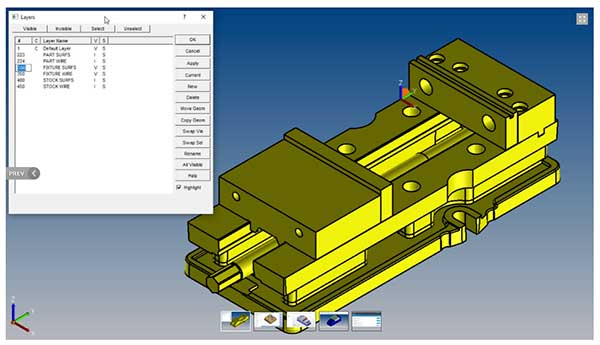Direct Link to Machining Simulation to Help Boost Efficiency
SURFCAM 2021 includes integration with NCSIMUL manufacturing simulation software to connect the virtual and real for greater productivity, company says.

Image courtesy of Hexagon.
Latest News
August 26, 2020
The new version of SURFCAM Traditional computer-aided-manufacturing (CAM) software offers a direct connection to the NCSIMUL machining simulation solution by Hexagon Manufacturing Intelligence, a development that provides SURFCAM programmers with greater control over the manufacturing process by delivering a more accurate and detailed picture of each machining operation from start to finish, the company says.
SURFCAM Traditional is designed to provide manufacturers with flexible and easy-to-use programming capabilities for 2-5-axis machining,
in addition to turning and wire-EDM programming functions. NCSIMUL machining-simulation software can be used in conjunction with a wide range of CAM systems to verify and optimize toolpath, quickly switch NC programs between machine tools and simulate machining operations.
By using a direct link to NCSIMUL from within the SURFCAM Traditional 2021 interface, SURFCAM users will have access to true G-code toolpath verification, editing and simulation functions to ensure that their NC programs are collision free and reflect the full CNC machining environment. This new associativity between the two systems also enables users to compare cut stock with original design geometry.
“Creating a digital thread that connects the virtual with the real ensures that manufacturers can achieve greater productivity without sacrificing quality because they're looking at accurate data throughout the entire manufacturing process,” says Machining Market and Product Manager Miguel Johann of Hexagon Manufacturing Intelligence.
“By using SURFCAM Traditional and NCSIMUL in tandem, users can pass the toolpath generated in SURFCAM—along with the part, fixture and stock geometry—to NCSIMUL for G-code validation, toolpath verification and a more detailed view of all operations.”
SURFCAM Traditional users can access NCSIMUL via the system's operations manager, which lists setups for operations in the order they'll be performed, as well as relevant machining data for each operation. From there, users can view the part within the NCSIMUL interface in various modes, including wireframe, facet, shading and shape modes. Tooling, tooling sequences, and toolpath can be viewed and edited within that same interface.
The direct link to NCSIMUL also enables users to digitally add or subtract part stock, and adjust fixturing, clamps, and cutting-tool libraries. Access to detailed virtual set-ups remove guesswork by providing accurate digital twins of complete machining environments that can then be recreated in the real world.
“This version of SURFCAM Traditional is focused on our core users' needs for general and advanced usage,” Johann says. “From beginner to expert, we are working to advance customer experience and usability.”
Additional enhancements available with the latest version of SURFCAM Traditional include the option for layer-based fixturing, which allows users to draw or import fixture geometry directly into the software instead of entering fixturing data numerically or via an external file.
With the new layering option, fixturing data resides on a set of layers defined by users, and the fixturing information is referenced during the toolpath-verification process. This improvement makes the management of fixturing data simpler and reduces opportunities for error.
Toolpath viewing capabilities have also been improved in the latest release, as toolpath can now be hidden with a single button click from the main toolbar. This new development saves time by simplifying the process of hiding toolpath for graphical clarity during the programming process.
Sources: Press materials received from the company and additional information gleaned from the company’s website.
More Hexagon Manufacturing Intelligence Coverage
Subscribe to our FREE magazine, FREE email newsletters or both!
Latest News
About the Author
DE’s editors contribute news and new product announcements to Digital Engineering.
Press releases may be sent to them via [email protected].






